Menu
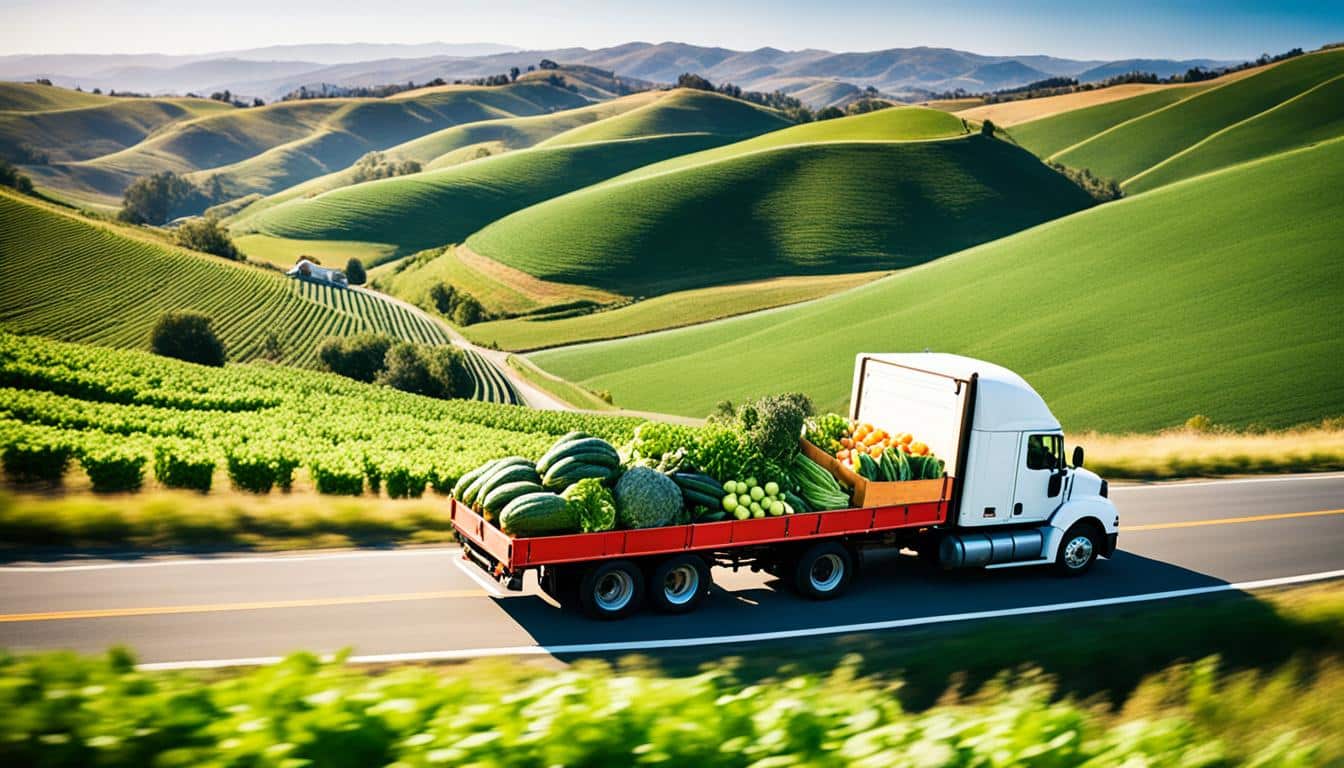
In 2018, a huge 3.3 billion tons of farm goods were transported around the world. Trucks did most of the moving. This shows us how important it is to have good ways to transport farm products. It helps keep farmers making money.
Natasha Post from TractorTransport.com says moving big and heavy farm gear costs a lot. This cuts into what farmers earn. But, with prices for their goods going up and down, they need to find smart ways to ship. Planning out the best routes, using special transport companies, and grouping shipments together are smart moves.
Choosing the best transport company is key. So is watching out for hidden fees. Farming at quieter times can save money. Making sure the insurance for farm machinery is right can also help. By making wise choices, farmers can run their business in a way that saves money and stays safe.
Delivering farm products needs careful planning for their freshness, especially organic goods. Understanding the supply chain and meeting quality standards are key for a smooth journey. Farm goods are carefully handled from the moment they’re picked until they reach the table.
The right packaging keeps farm produce fresh. Using the best materials can make a big difference. For example, breathable packaging helps control moisture. Seal moisture-sensitive products well to keep them good.
Choosing the best way to transport farm goods matters a lot. Options like refrigerated trucks, air shipping for fast-spoiling items, and web sales for stable products offer flexible shipping. Each choice has its benefits in speed, condition control, and value.
But, it’s not just about the transport and packaging. Working with local businesses and groups helps get fresh produce to more people. It and can build more interest in the farm’s products. Such partnerships help in reaching different kinds of buyers.
Engaging with the community directly at markets or through special farm activities keeps customers coming back. It lets consumers meet the farmers, which builds trust in the products.
So, the path from the farm to your table involves many decisions. The focus is on keeping the produce fresh and high-quality. Also, using social media and smart marketing can make farm businesses more popular. This helps them stay true to their promise of delivering fresh, healthy food.
Transporting agricultural goods is key in our food chain, especially for products from rural places. Today, farm-to-table delivery services are changing the game, making life easier for customers. Getting the temperature right, being on time, and handling items with care are vital for getting farm products to their destination safely.
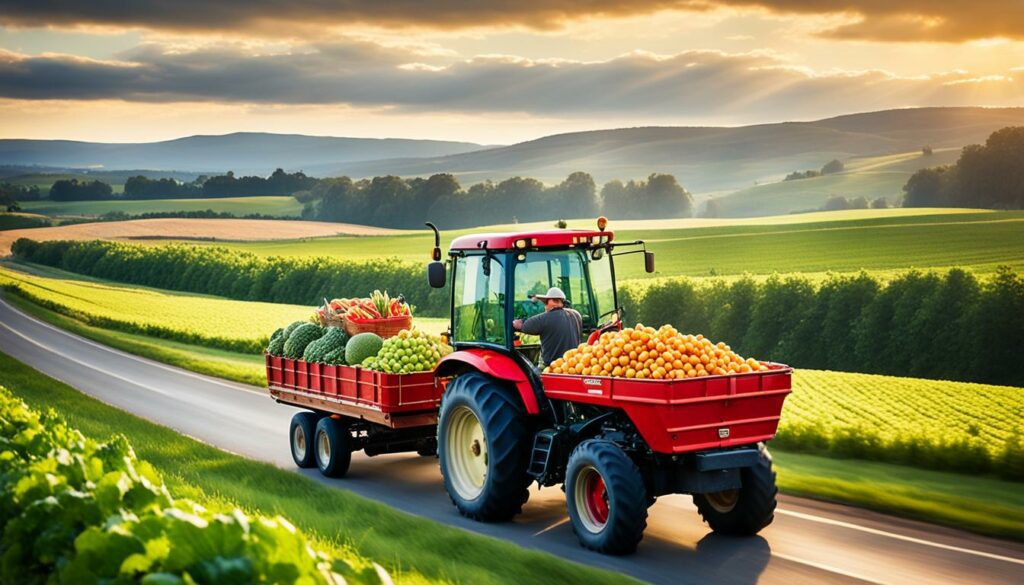
Looking into the essentials of farm product shipping means digging deep into the costs. There are costs that change, like tyres and fuel, labour, and repairs. Then, there are fixed costs, such as insurance and taxes. Understanding these differences is crucial for a sound business plan.
The break-even point is an essential tool in farm management, as it aids in understanding the relationship between prices, volume, and costs.
It’s not just about moving the products though. Spending on marketing should be considered in the delivery prices. This ensures a smart strategy in getting food from the farm to your table. The Porter’s Five Forces model helps gauge the delivery market effectively. Including extra services like easy pick-up or drop-off can make customers even happier.
Ways like offering credit make the service more convenient and profitable. Transporting organic goods needs extra care, since they are chemical-free. This means controlling temperatures and handling them with great attention.
| Cost Type | Examples |
|---|---|
| Variable Costs | Tyre costs, Fuel and oil costs, Labour costs, Repairs, and Maintenance |
| Fixed Expenses | Ownership costs like Insurance, Licensing fees, Registration fees, Taxes, Depreciation, Financing charges |
Good delivery management is crucial for keeping produce fresh and maintaining high standards. Doing this well doesn’t just keep the food good; it shows a deep care for customer health and satisfaction.
Managing how farm equipment moves is critical. It cuts fuel costs and makes deliveries on time. Technology plays a big part in this. Advanced software and GPS help save money and keep operations efficient.
In today’s agriculture, using tech for route planning is a must. Software tools make planning times much shorter than before. They use special formulas to find routes that save up to 10% on average mileage. This reduces fuel use and the vehicles last longer.
Companies like Verizon Connect are known for easy-to-use route planning software. They scored 8.76 out of 10 for usability. This kind of software also handles changes easily. You can make quick new plans if jobs are added or cancelled.
Route planning is more than picking the shortest route. It’s about cutting miles and costs. The latest software considers many things to give the best routes. This improves how fleets move, saving fuel and vehicle wear.
| Year | Increase in Truck Shipments for Grain Products |
|---|---|
| 2000 | 50% |
| 2016 | 75% |
Using fleet routing software also makes better use of resources. It prevents doing extra work, saving time and money. It quickly spots where routes can be improved, ensuring the farm runs efficiently and affordably.
Lastly, providing accurate arrival times boosts customer happiness. It shows how well advanced route planning works in delivering farm equipment on time.
Consolidating shipments helps farmers and shippers cut costs and streamline operations. It uses the benefits of bulk transport to save money. This approach is key to lowering expenses and improving how shipments are grouped.

Shipping produce can range from $1.83 to $2.56 for every mile. In the Midwest, reefer rates can hit $2.56. This makes combining loads a smart move because it saves money. By combining multiple loads, you make fewer trips and find the best routes. This leads to big savings. Also, consolidated LTL shipments can arrive faster with less stopping, making the whole process more efficient.
Less truck usage means less risk for product damage or loss. Fewer times you load and unload lowers the chance of mistakes. This keeps the products safe and on time. Also, it’s good for the environment. Fewer trucks mean less pollution.
Planning the best routes is really important. It makes sure items stay fresh while cutting down delivery times. Investing in good logistics and consolidation contributes to long-term success and helps the planet too.
Maintaining farm machinery through regular preventative maintenance is key. It ensures smooth and reliable shipping. This approach also saves time and money by preventing transport issues.
Preventative maintenance lowers the chance of breakdowns. It makes shipping more reliable, improving the farm’s efficiency.
It’s vital to prep machinery before shipping. This helps avoid delays and repair costs. Regular checks and maintenance are essential. They help machinery stay in top shape.
Studies show that 78% of companies see longer machine life with proper maintenance. This saves money by cutting down on sudden failures. It also ensures smooth shipping operations.
Preventative maintenance helps cut down on repair bills. It increases equipment life. However, without focusing on the main problem areas, up to 50% of the budget might be wasted.
Regularly serviced machinery needs less unexpected repairs. This saves money by reducing the need for quick deliveries and emergency technicians. Proper upkeep keeps equipment working well, making shipping smoother and cheaper.
| Advantages | Statistics |
|---|---|
| Increased Equipment Lifespan | 78% of companies report improved lifespan |
| Cost Reduction | Unplanned maintenance costs 3 to 9 times more than planned maintenance |
| Reduced Breakdowns | 90% of mechanical failures are preventable |
| Improved Safety | Properly maintained equipment complies with safety regulations |
To sum up, a strong preventative maintenance plan is a must. It ensures equipment readiness, cuts down on costs, and keeps shipping reliable. This boosts efficiency and customer satisfaction while saving on unnecessary expenses.
Choosing the right transportation provider is key. You need a partner who meets high efficiency and reliability standards. This is crucial for managing the transportation of large items safely and smoothly.
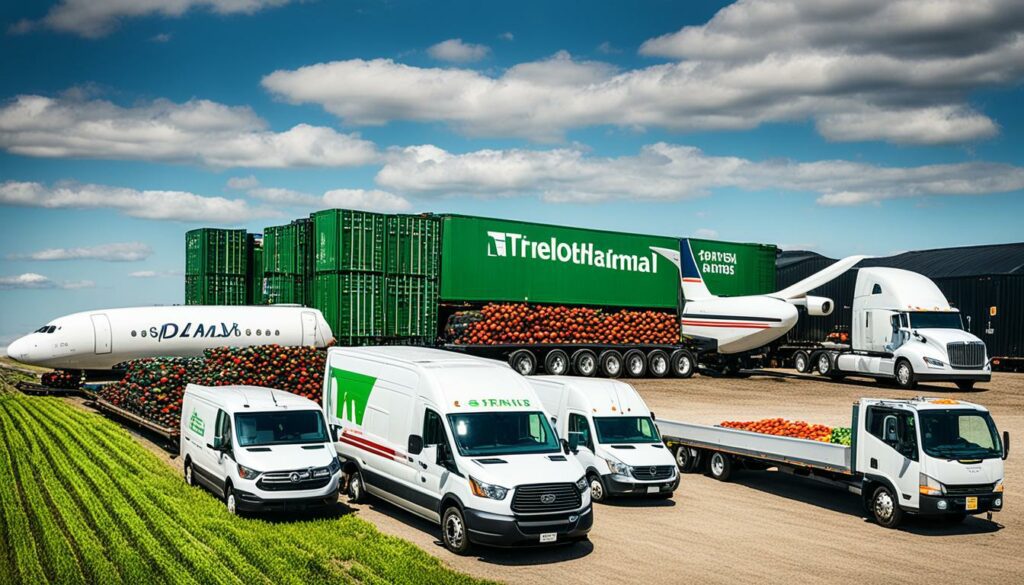
Knowing the costs of farm transport is vital. Costs like tyres, fuel, and labour rise when moving more items. Having a strong cost plan helps figure out costs at different levels and the break-even point.
The break-even point is when sales match total costs. Knowing this helps make smart choices in freight management. It prevents financial problems and lets you use resources well.
It’s also important to think about several factors to make operations better. For example, using the best routes and splitting deliveries can save money. Training staff to plan better routes means they meet delivery times, keeping customers happy.
Showing how your delivery prices help customers can boost sales. Knowing about Porter’s Five Forces helps businesses deal with competition and other pressures. This info is crucial for strategic planning.
Adding special services can make your business stand out. Options like picking up at a parking lot or taking payments online make customers happy. As online sales grow, having a reliable delivery service is more important than ever.
Environment-friendly shipping is also key. Cutting down on last-mile delivery emissions can help the planet. Using zero-emission fleets shows you care about the environment, something many customers like.
So, choosing a transportation provider takes careful thought. Look for one that is cost-effective, reliable, and eco-conscious. With the right partner, your farm’s goods will get to customers safely and on time.
Organic produce shipping involves several important factors to ensure top-quality delivery. First, keeping produce fresh is key. Organic items have no preservatives, so they spoil faster. This means keeping them at the right temperature is crucial to maintaining produce freshness.
Meeting regulations is also vital in organic produce shipping. Farmers must follow USDA organic rules. These cover how produce is processed, packed, and stored. Following these rules keeps products organic and free from mixing with non-organic items.
The right packaging is crucial for keeping organic produce safe during shipping. It needs to allow for airflow but also protect the items. Using packaging that’s certified as organic helps meet rules and keeps produce fresh.
Managing costs and ensuring profits are also key when shipping organic produce. It can cost between $400 and $600 per share in a program like Community Supported Agriculture (CSA). But organic farmers can earn more money due to the high value consumers place on organic products.
| Key Consideration | Implication | Solution |
|---|---|---|
| Temperature Management | Ensures freshness during transit | Refrigerated trucks, insulated packaging |
| Regulatory Compliance | Maintains organic certification | Adhere to USDA standards, use certified packaging |
| Packaging | Protects produce and prevents contamination | Ventilated, organic-certified materials |
| Cost Management | Offsets initial shipping investment | Utilise price premiums, streamline logistics |
Lastly, staying updated with market trends can help improve shipping. Information from certifying bodies and buyer feedback can be valuable. With the increasing demand for good-quality local food, smart shipping strategies are essential to keep up.
Keeping food fresh during shipment is key. A lot of money is involved. The cold chain market was worth around $248.4 billion in 2020. It’s expected to grow to over $410 billion by 2028.

Preventing spoilage in food is critical. Tools like dry ice and gel packs help keep things cold. Automated cool containers are also popular for their accuracy. Lohcally Artisan Chocolates aims for quick deliveries to keep their products perfect.
Getting the timing right in shipping is very important. Temujin Foods, for example, ensures orders are perfect, arriving by Thursday after placing them by Sunday night. They do this using dry ice to make it happen fast.
For drugs, by 2024 the market will have grown huge, to $21.3 billion. This is helped by super cold storage, keeping vaccines at -70°C for three weeks. These advancements show how keeping things cold is vital for shipping food and drugs. This makes the industry very important for the future.
Choosing the right packaging is crucial for perishable agricultural items. The kind of packaging you pick can greatly affect how long these items stay fresh. Different materials work better for different items.
Breathable packaging materials are best for items that need air. They let air move around, cutting down on moisture. Too much moisture means the goods might go bad. It also helps keep away mould. Using these materials keeps the food fresh and safe all the way to your plate.
If your items don’t like wet air, sealing them up is the answer. A type of sealing, called modified atmosphere packaging, changes the inside air. It keeps just the right amount of oxygen and carbon dioxide for the item. This can make certain goods last longer. Keeping the package tightly closed also stops anything bad from the outside getting in. This keeps the items safe and good to eat on their journey.
Mixing both air-friendly and sealed packaging methods helps all kinds of produce stay fresh. These strategies protect the goods, keeping them in top condition. It ensures they last longer and are safe to enjoy.
Shipping organic produce is strict. It follows rules from the USDA. These rules help keep organic items high-quality during travel.
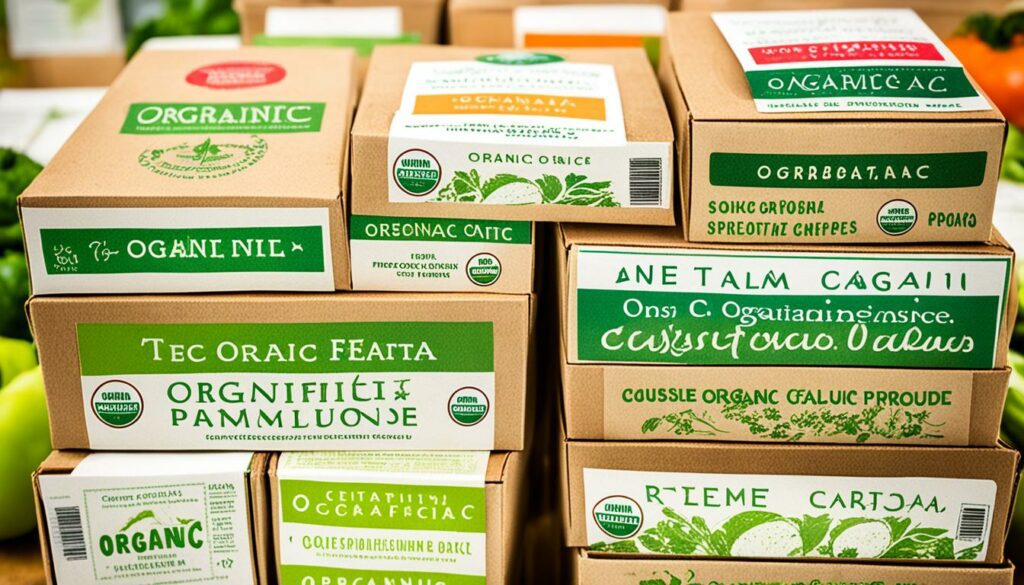
The USDA’s rules are tough. They make sure organic food keeps its status. This means keeping organic and not organic items apart on the way.
Transporters must keep very careful records. They need to show they clean their vehicles and storage places. This prevents any mixing that could make food lose its organic title.
To keep organic status, strict steps are necessary. Transporters must document every step well. They also have to regularly check and clean their vehicles to avoid mixing.
The companies that haul organic food must follow local and federal rules. This is to make sure the food stays organic. It’s a big job, but it’s important for keeping the food in line with organic standards.
| Key Considerations | Details |
|---|---|
| Separation | Ensure organic products are kept apart from non-organic items during transport. |
| Record Keeping | Maintain comprehensive records of cleaning, handling, and shipping procedures. |
| Transport Equipment | Use vehicles and storage facilities that are inspected and cleaned to prevent contamination. |
| Local & State Compliance | Adhere to specific local and state regulations, alongside federal standards. |
By following shipping rules well, organic standards and certifications stay secure. This protects the organic nature of the food from start to finish.
Rural transport faces many hurdles. It’s vital to deliver farm products well. Farmers rely a lot on others to carry their goods. Transport in the countryside is costly, making things harder.
Bad weather can harm the movement of farm goods. It might delay them or cause damage. To deal with this, farmers watch the weather closely and plan ahead. They use tools like GPS to react fast to changes. This helps them adjust their routes quickly to avoid problems.
To fight against delays, farmers need to work on many fronts. Poor roads and few facilities can delay their shipments. They use smart software and step up their links with suppliers. Also, having more storage can keep food from going bad. This helps reduce their losses.
Analyzing data is key to find and fix problems. By using digital tools, farmers learn a lot about how their goods are moving. This helps them manage their shipping better and solve issues faster.
Choosing the best produce transportation methods is key. It ensures fruit and veg stay fresh when they arrive. Getting this choice right helps the U.S. economy a lot. In 2015, it added nearly $1 trillion to the economy and created over 21 million jobs by 2017.
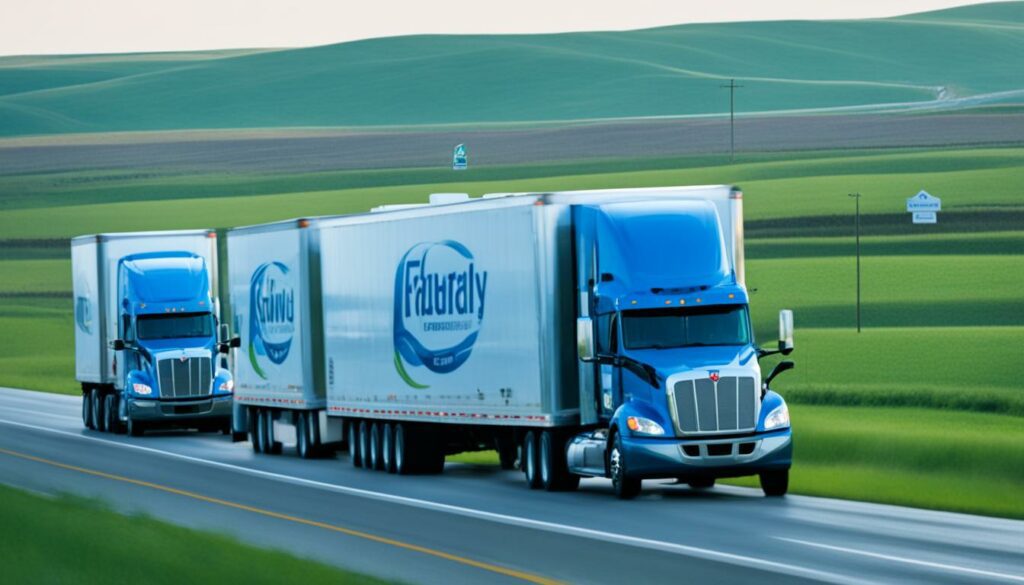
Refrigerated trucks play a big role in moving produce. They keep a perfect environment for fruits and vegetables. This is crucial for short to medium trips. They are perfect for taking food to other countries too. In 2018, this helped bring about $140 billion to the U.S. economy.
Air freight is best for items that need to move fast and stay fresh. It might cost more but it’s fast and efficient. For example, in 2016, U.S. exports to Canada and Mexico were worth $38.1 billion. Air freight is a smart choice for keeping up with these growing demands.
Choosing refrigerated trucks for things like fresh fruit or air freight for speed is important. It meets the needs of moving fresh produce well. Each way of transport has its good points, which are vital for getting the produce to its market well.
Cost management in moving farm goods is key for success. Knowing about pricing, like dimensional weight, and using smart shipping methods is vital. It can cut down on the money spent on moving goods.
Shipping companies use dimensional weight for packages. This looks at both the size and weight. It makes sure big but light packages don’t cost too little to ship. To save money, use small packages. This will cut down on the weight and cost of shipping.
There are two kinds of costs in shipping: variable and fixed. Variable costs change with distance and how much is shipped. Fixed costs stay the same all the time. Managing both well is essential for knowing how much it really costs to ship goods.
Adding some of the marketing costs to the shipping price helps with cost management. This can make the customer aware of the product’s quality. It could also make them more likely to choose the delivery service. Adding new services, like picking up from parking lots, or more ways to pay, can make the delivery service better and more appealing.
Effective farm product shipping strategies include planning routes carefully and combining shipments. Using specialist transport firms and doing regular check-ups on the vehicles are also key. This helps balance travel and costs for better efficiency and to be eco-friendly.
Introducing farm product shipping means thinking about the journey from farm to plate. It’s about keeping produce fresh. Selecting the right transport, following rules, and using good packing help keep quality high.
Agricultural goods need special care. Keeping the right temperature, handling them with care, and choosing correct transport are essential. This is crucial for organic goods, which can’t use chemicals to protect them.
To make farm equipment transport smoother, use GPS and route optimisation. This avoids wrong turns. It’s important to balance miles and costs well for efficiency and the environment.
Bringing shipments together saves money. It cuts down on loading and unloading. This way, there’s less risk of damage, costs go down, and things move more smoothly.
Keeping farm machines well-maintained is vital before shipping. It stops damages and lowers repair costs. Good care means machines last longer, work better when they arrive, and things run without delays.
Choosing a trustworthy transport partner can save money and make things run better. They know how to move big loads safely. This reduces mistakes or accidents that could be costly.
When shipping organic, remember its certification and freshness. Avoiding contamination is a must. Keep the right temperature, follow rules, and use the best packaging materials.
Keeping food at the right temperature is crucial for freshness. It’s all about managing heat changes, timing, and careful handling. Refrigerated trucks or special packaging stop food from going bad.
Choose breathable packaging for goods that don’t like moisture. For fragile things, pick sealed ones with special air inside. Don’t forget clear instructions on handling.
Organic shipping must meet USDA standards. This means keeping organic items separate, keeping everything clean, and noting everything down. You must also follow local and state laws.
To deal with bad weather and delays, keep an eye on the forecast. Have a backup plan ready and use tools like GPS to stay in touch. Knowing reliable partners is also key.
Refrigerated trucks work well for most produce. Air freight is best for goods that spoil easily and need to get there fast. The method must fit the goods’ needs and timing.
Save money on shipping by designing smart packages and using ground delivery for close places. It’s also smart to figure shipping costs in with the product price. This and looking into varied pricing plans can keep profits up.